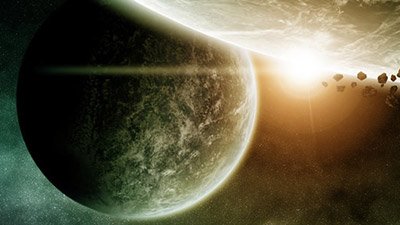
Astronomers On the Verge of Finding Extrasolar Planets like Earth
Sooner or later, say some astronomers, we’ll run across an extrasolar planet so similar to our own planet that we’ll be able to call it “Earth’s twin.”
News Source
- LiveScience: “Astronomers on Verge of Finding Earth’s Twin”
The claim is based on recent discoveries of extrasolar planets (or “exoplanets”) increasingly similar to Earth, such as the discovery last week of three planets with masses between “only” two and ten times that of Earth. (Previously discovered exoplanets have mostly been significantly larger than Earth—much more similar to the gas giants in our own solar system—because such exoplanets are more easily detected.)
Commenting on last week’s news, planet formation theorist Alan Boss of the Carnegie Institution explained that, “Being able to find three Earth-mass planets around a single star really makes the point that not only may many stars have one Earth, but they may very well have a couple of Earths.” University of California–Berkeley astronomer Geoff Marcy adds, “So far we’ve found Jupiters and Saturns, and now our technology is becoming good enough to detect planets smaller, more like the size of Uranus and Neptune, and even smaller.”
And what’s the big goal of most astronomers who are looking for Earth’s twin? LiveScience elucidates:
Such a twin would be rocky, with a similar chemical composition to Earth, and would orbit within the habitable zone of its star. . . . Finding a planet in the habitable zone is the first step toward finding alien life.
As we’ve pointed out before, these astronomers aren’t actually able to directly see exoplanets, and thus (with current technology) we wouldn’t be able to photograph an “Earth twin” even if we found one. All of the detection is indirect, through calculations based on a star’s position (as influenced by the gravity of its planets) or brightness (as diminished by the transit of a planet “in front” of the star).
Then there’s the idea of what an Earth-like planet is. For an evolutionist, any planet discovered with liquid water and an environment even very roughly similar to Earth’s might be labeled “Earth’s twin,” even if no human would have a hope of surviving on it.
When evolution-believing astronomers discuss exoplanets and our likelihood of finding Earth-like planets, their hopes hinge on their outright faith that where water exists, life will soon evolve, almost as if it were a necessary consequence.
The discovery of exoplanets of all shapes, sizes, and compositions shouldn’t trouble Christians—nor should anything, for that matter, when we start with God’s Word. In fact, when you think about it, the primarily Darwinian-driven search for extraterrestrial life has come empty so far, even though not so long ago Mars, the moon, or even Venus was thought to possibly harbor life. As we learn more about what lies beyond our solar system, we can (and do!) praise our Creator for the marvels of matter He made on Day 4 of Creation Week—and the marvels of life He created on Days 3, 5, and 6 on Earth.
Further Reading
- The Existence and Origin of Extrasolar Planets
- Extrasolar Planets Suggest our Solar System is Unique and Young
- Are Aliens Real?
- Get Answers: Alien Life, Astronomy
- Taking Back Astronomy
For More Information: Get Answers
Remember, if you see a news story that might merit some attention, let us know about it! (Note: if the story originates from the Associated Press, FOX News, MSNBC, the New York Times, or another major national media outlet, we will most likely have already heard about it.) And thanks to all of our readers who have submitted great news tips to us. If you didn’t catch all the latest News to Know, why not take a look to see what you’ve missed?
(Please note that links will take you directly to the source. Answers in Genesis is not responsible for content on the websites to which we refer. For more information, please see our Privacy Policy.)
Recommended Resources

Answers in Genesis is an apologetics ministry, dedicated to helping Christians defend their faith and proclaim the good news of Jesus Christ.
- Customer Service 800.778.3390
- Available Monday–Friday | 9 AM–5 PM ET
- © 2025 Answers in Genesis




